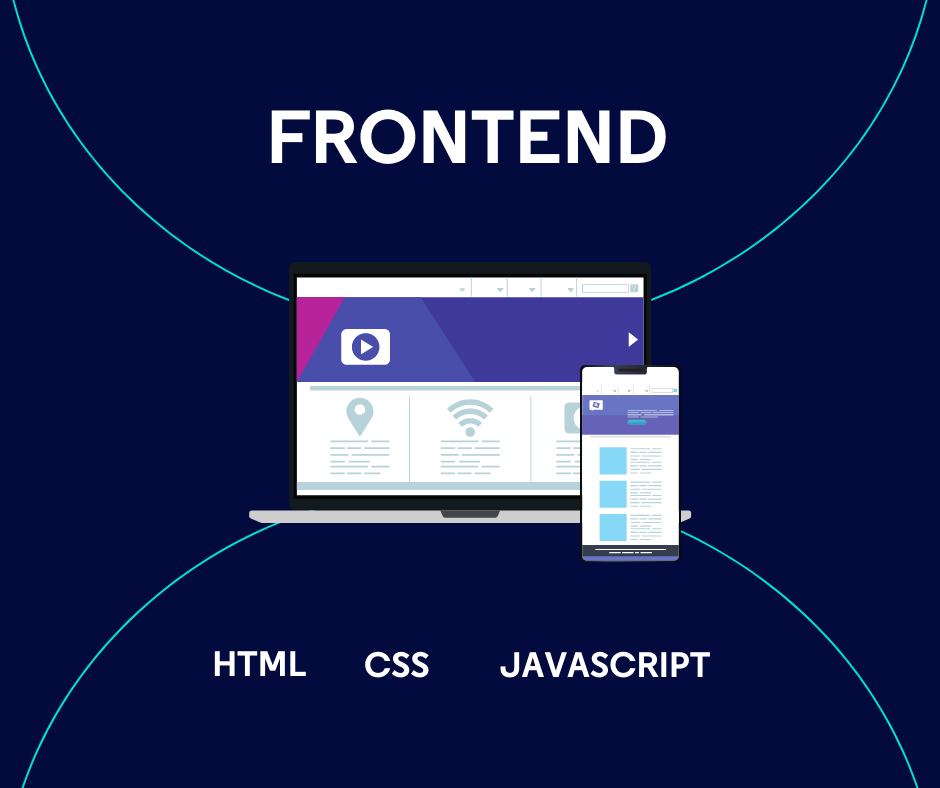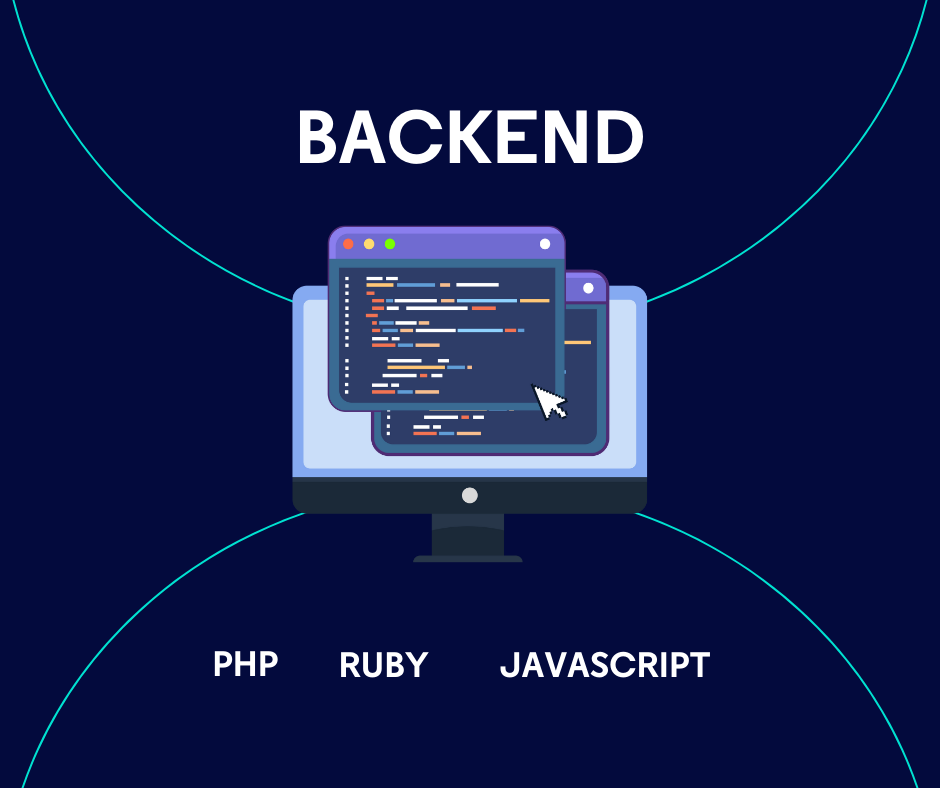
Frontend vs Backend – What's the Difference? Detailed Explanation
Both web development and the entire IT world base many activities on the division into frontend and backend. And although we can hear both terms very often, not everyone (especially people from outside the industry) is aware of how they differ and are characterized. To help you understand these issues, in this article, we'll discuss the frontend and backend, showing the main differences, as well as popular languages and frameworks that can be used to work on a website.
What is frontend?
Imagine a clock on the wall. The dial with clock hands shows us the current time. As users, we see only the presentation of data (in this case – the time), i.e. the frontend, but we don't have any insight into what is hidden under the housing (we'll discover it together further down the article).
Translating this example into websites, we can define the frontend as the visual part of a web page presented to the user, i.e. its design, general appearance, or the entire interface. Moreover, the frontend is responsible for how the user interacts with the website or web application, and how it reacts to their actions.
Frontend languages
Frontend languages allow us to create a user interface, as well as interactive support for website functionalities, such as searching or modifying content in real time. Without them, the user wouldn't see a representation of any content on the website. Let's take a look at examples of such languages.

HTML
The most popular frontend language by far is HTML, which is responsible for the structure of a website. It allows putting on it appropriate tags, such as headings (e.g. H1, H2, H3, which are essential in terms of SEO), images, links, tables, and lists. It all starts with HTML – this simple language organizes the web page and gives it a proper layout.
CSS
Now we can move on to defining the basic look of our web page, which means that CSS comes into play. Thanks to it, we can give appropriate styles to the website. This is closely related to the structure previously created in HTML. It’s here that we define such parameters as font size, the final arrangement of elements, or their colors.
JavaScript
We can also add JavaScript to the above set of technologies (contrary to popular opinion, the only thing it shares with Java is part of its name). Using this frontend language, we write the scripts executed on the user's side. We can add interactive elements and manage their dynamic behavior within the website or web application.
It's thanks to this technology that after clicking on the icon with three stripes, a mobile menu will appear on the side of the web page. Responsive sliders or drop-down lists are another basic elements that we can see on the website owing to JavaScript.
What's interesting, practically the same programming language will also appear later in the article when we discuss backend languages.
Frontend frameworks
When discussing programming languages, it's impossible not to mention frameworks, i.e. a set of tools and libraries that help programmers create software. Most applications contain similar functionalities, such as database connection or page rendering. By providing these elements, frameworks save a lot of time due to not having to write the same basic elements. In addition, they often impose good programming practices, which increases the quality of the code.
The most popular frontend frameworks include AngularJS, React, and Vue.js. They provide a set of ready-made JavaScript components and tools that support developers in creating complex and interactive user interfaces. Let's take a look at each of these frameworks.
Angular
Angular is an end-to-end solution developed and maintained by Google. It uses a component-based architecture and two-way data binding. Due to its great complexity and number of possibilities, it's well suited to building complicated applications on a large scale, and at the same time, it's also used for SPA (Single Page Application) websites.
React
On the websites of Netflix, PayPal, and Walmart, we can see how well the popular React framework works. This efficient and flexible tool uses a virtual DOM (Document Object Model). It's a programming concept based on storing the "virtual" representation of the user interface in memory and synchronizing it with the "real" DOM model (more inquisitive readers may want to check out the React documentation, which describes this in detail). However, the advantages of React don't end there. Among the most important ones, it’s also worth mentioning: one-way data flow, high stability, and – in combination with Next.js – the positive impact on SEO.
Vue.js
Another framework worth paying attention to is Vue.js. The solution created in 2014 by a former Google employee, Evan You, is also component-based but differs from React and Angular due to the smaller library size, greater intuitiveness, and configurability. Being an extremely flexible tool, it's used both in smaller and more advanced websites. Vue is also the most popular framework among large Chinese companies such as Alibaba and Baidu.
Frontend libraries
In addition to frontend languages and frameworks, also noteworthy are frontend libraries, i.e. pre-written code that can be easily added to a website or web application. Examples include: jQuery, Bootstrap, and Material-UI. These libraries can be used to quickly add functionalities and improve the overall appearance of the website. The main advantage of using them is time-saving, especially when performing repetitive elements.
What is backend?
Now that we know how the frontend works, it's time to answer the question of what the backend is. To do this, let's go back to the clock example – but this time, we take it off the wall and turn it over. Now we can observe what most of the time is invisible to the eye, i.e. the mechanism that is responsible for telling the time. The backend works in a similar way.
This part of a website includes the server, database, and APIs. The backend is therefore responsible for handling user requests, data management, and communication with other systems. It's a code that is able to extract information from the database, process it, and transfer it to be displayed, i.e. to the frontend.
Backend languages
The backend can be supported by languages such as PHP, Ruby, or the aforementioned JavaScript. We use each of them to write server-side logic and to handle data. Let's take a closer look at them.

PHP
PHP is a server-side scripting language used by many popular content management systems (CMS), such as Drupal and WordPress. PHP has been around since 1995, and to this day gathers a large community of programmers around it, which means that there are many libraries and frameworks available. During regular updates, committed developers introduce a whole range of modern improvements to it, thanks to which, when working with PHP, we won't notice that it’s been around for almost 30 years.
Ruby
Ruby has a simple, elegant syntax and is known for its "convention over configuration" philosophy, which makes it easy for developers to get started. It's based on some assumptions about what and how we want to achieve, so it doesn’t require us to set every little option in configuration files. This language is ideal for writing backends for advanced projects. If we're planning, for example, a mobile application or a website based on a headless CMS system, Ruby is a great choice. It's also used in many other areas, such as game development, data analytics, and artificial intelligence development.
JavaScript
JavaScript is such a versatile programming language that it can be used for both frontend and backend development. For backend development, JavaScript can be used with Node.js, a JavaScript runtime that allows developers to run it on the server side, giving us the ability to use it to create our own HTTP server or other web services. Thanks to this, it's possible to build full applications in a single language and share the code between the frontend and backend.
Backend frameworks
Backend frameworks are a set of tools for a specific programming language. They provide developers with ready-made solutions, such as tools for database support or user session management, which allows us to focus on building the business logic of the application instead of creating basic functionalities from scratch.
Symfony
We have to mention Symfony, especially in the context of websites written on the basis of CMS Drupal, i.e. using PHP.
This framework was created to help developers build robust, scalable, and maintainable web applications. It was designed in accordance with the Model-View-Controller architectural pattern, based on the division of the application into three main parts, and provides a set of tools and components for common page-building tasks, such as routing, form handling, and database access. One of the key features of Symfony is the use of dependency injection and a service container, which allows for more flexible and decoupled code.
Symfony is used not only by Drupal, but also systems such as Pimcore – for managing product information, customer data, and digital assets, as well as the Magento ecommerce platform.
Laravel
Staying with PHP, we can also take a look at the Laravel framework, which has a lot of built-in functions that facilitate the implementation of common web development tasks, such as routing, authentication, and caching. Laravel also provides an uncomplicated and elegant syntax and additionally has a simple mechanism for interacting with databases.
Working with this framework, we can save a lot of time by using ready-made elements, such as authentication at registration and login pages, Blade templates, or a built-in task scheduler.
Next.js
When executing the backend in JavaScript, we can use, e.g. Next.js. It's a framework built in TypeScript and strongly inspired by the previously mentioned Angular. It provides a modular structure for building scalable and maintainable server applications. Next.js is based on Express.js and extends it with additional features. With it, we can render a website on the server side, which not only significantly speeds up the loading of applications and websites but also positively affects SEO.
Frontend vs backend – the difference
What's the main difference between the frontend and backend? The frontend is responsible for the user interface and how the visitors interact with the website, while the backend is behind the logic and data of the website or application.
This relationship is best illustrated by the example of a contact form. The elements that the user can see and fill out are the result of the frontend, and the process of sending data from the form to the database is the backend.
Another more comprehensive example is an online store website. Every element that the customer sees on the page, such as the product grid, images, and content, is the frontend. But the processes such as shopping cart handling, payment processing, order processing, interaction with the store database, or generating reports, are tasks performed by the backend.
Frontend and backend – dependent or independent of each other
In our considerations, the question may arise whether both departments can exist independently of each other. The answer is ambiguous and should be considered in several contexts.
Both parts of the system are dependent on each other because they work together, creating a complete internet application. The frontend sends and receives backend data, and the backend processes and stores it. Without backend, frontend couldn't function, and without frontend, backend couldn't provide user interface.
Another case is when we design one architecture to provide data, for example, to a mobile application and several websites. It can be described as a standalone system then, and only the backend is needed.
Sometimes we can also encounter an opposite situation where we develop a website that doesn't require much business logic. The frontend elements are enough. No data will be processed, they won't be saved anywhere, and the website will only present permanent content for the user. A simple advertising single page for a product can serve as a perfect example here.
Our team of programmers works on web development using the frontend and backend on a daily basis. We implement both simple and complex web pages with many functionalities, so we can easily help you develop the frontend and the backend, as well as both parts at the same time.











